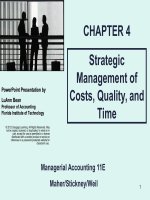Operation management 11e heizer render chapter 04
Bạn đang xem bản rút gọn của tài liệu. Xem và tải ngay bản đầy đủ của tài liệu tại đây (1.27 MB, 124 trang )
Forecasting
4
PowerPoint presentation to accompany
Heizer and Render
Operations Management, Eleventh Edition
Principles of Operations Management, Ninth Edition
PowerPoint slides by Jeff Heyl
© 2014
© 2014
Pearson
Pearson
Education,
Education,
Inc.Inc.
4-1
Outline
▶ Global Company Profile:
Walt Disney Parks & Resorts
▶ What Is Forecasting?
▶ The Strategic Importance of
Forecasting
▶ Seven Steps in the Forecasting
System
▶ Forecasting Approaches
© 2014 Pearson Education, Inc.
4-2
Outline - Continued
▶ Time-Series Forecasting
▶ Associative Forecasting Methods:
Regression and Correlation Analysis
▶ Monitoring and Controlling Forecasts
▶ Forecasting in the Service Sector
© 2014 Pearson Education, Inc.
4-3
Learning Objectives
When you complete this chapter you
should be able to :
1. Understand the three time horizons and
which models apply for each use
2. Explain when to use each of the four
qualitative models
3. Apply the naive, moving average,
exponential smoothing, and trend
methods
© 2014 Pearson Education, Inc.
4-4
Learning Objectives
When you complete this chapter you
should be able to :
4. Compute three measures of forecast
accuracy
5. Develop seasonal indices
6. Conduct a regression and correlation
analysis
7. Use a tracking signal
© 2014 Pearson Education, Inc.
4-5
Forecasting Provides a
Competitive Advantage for Disney
►
Global portfolio includes parks in Hong Kong,
Paris, Tokyo, Orlando, and Anaheim
►
Revenues are derived from people – how
many visitors and how they spend their
money
►
Daily management report contains only the
forecast and actual attendance at each park
© 2014
© 2014
Pearson
Pearson
Education,
Education,
Inc.Inc.
4-6
Forecasting Provides a
Competitive Advantage for Disney
►
►
►
Disney generates daily, weekly, monthly,
annual, and 5-year forecasts
Forecast used by labor management,
maintenance, operations, finance, and park
scheduling
Forecast used to adjust opening times, rides,
shows, staffing levels, and guests admitted
© 2014
© 2014
Pearson
Pearson
Education,
Education,
Inc.Inc.
4-7
Forecasting Provides a
Competitive Advantage for Disney
►
►
►
20% of customers come from outside the
USA
Economic model includes gross domestic
product, cross-exchange rates, arrivals into
the USA
A staff of 35 analysts and 70 field people
survey 1 million park guests, employees, and
travel professionals each year
© 2014
© 2014
Pearson
Pearson
Education,
Education,
Inc.Inc.
4-8
Forecasting Provides a
Competitive Advantage for Disney
►
►
►
Inputs to the forecasting model include airline
specials, Federal Reserve policies, Wall
Street trends, vacation/holiday schedules for
3,000 school districts around the world
Average forecast error for the 5-year forecast
is 5%
Average forecast error for annual forecasts is
between 0% and 3%
© 2014
© 2014
Pearson
Pearson
Education,
Education,
Inc.Inc.
4-9
What is Forecasting?
►
Process of predicting a
future event
►
Underlying basis
of all business
decisions
►
Production
►
Inventory
►
Personnel
►
Facilities
© 2014 Pearson Education, Inc.
??
4 - 10
Forecasting Time Horizons
1. Short-range forecast
►
Up to 1 year, generally less than 3 months
►
Purchasing, job scheduling, workforce levels,
job assignments, production levels
2. Medium-range forecast
►
3 months to 3 years
►
Sales and production planning, budgeting
3. Long-range forecast
►
3+ years
►
New product planning, facility location,
research and development
© 2014 Pearson Education, Inc.
4 - 11
Distinguishing Differences
1. Medium/long range forecasts deal with more
comprehensive issues and support
management decisions regarding planning
and products, plants and processes
2. Short-term forecasting usually employs
different methodologies than longer-term
forecasting
3. Short-term forecasts tend to be more
accurate than longer-term forecasts
© 2014 Pearson Education, Inc.
4 - 12
Influence of Product Life
Cycle
Introduction – Growth – Maturity – Decline
►
Introduction and growth require longer
forecasts than maturity and decline
►
As product passes through life cycle,
forecasts are useful in projecting
►
Staffing levels
►
Inventory levels
►
Factory capacity
© 2014 Pearson Education, Inc.
4 - 13
Company Strategy/Issues
Product Life Cycle
Introduction
Growth
Best period to
increase market
share
Practical to change
price or quality
image
R&D engineering is
critical
Strengthen niche
Maturity
Decline
Poor time to
change image,
price, or quality
Cost control
critical
Competitive costs
become critical
Defend market
position
Drive-through
Internet search engines
restaurants
Xbox 360
Boeing 787
Sales
3-D game
players
DVDs
iPods
3D printers
Electric vehicles
Analog
TVs
Figure 2.5
© 2014 Pearson Education, Inc.
4 - 14
OM Strategy/Issues
Product Life Cycle
Introduction
Growth
Product design
and development
critical
Forecasting critical
Standardization
Frequent product
and process
design changes
Product and
process reliability
Competitive
product
improvements and
options
Fewer product
changes, more
minor changes
Short production
runs
High production
costs
Limited models
Attention to quality
Increase capacity
Shift toward
product focus
Enhance
distribution
Maturity
Optimum capacity
Increasing stability
of process
Long production
runs
Product
improvement and
cost cutting
Decline
Little product
differentiation
Cost
minimization
Overcapacity in
the industry
Prune line to
eliminate items
not returning
good margin
Reduce
capacity
Figure 2.5
© 2014 Pearson Education, Inc.
4 - 15
Types of Forecasts
1. Economic forecasts
►
Address business cycle – inflation rate, money
supply, housing starts, etc.
2. Technological forecasts
►
Predict rate of technological progress
►
Impacts development of new products
3. Demand forecasts
►
Predict sales of existing products and services
© 2014 Pearson Education, Inc.
4 - 16
Strategic Importance of
Forecasting
►
Supply-Chain Management – Good
supplier relations, advantages in product
innovation, cost and speed to market
►
Human Resources – Hiring, training,
laying off workers
►
Capacity – Capacity shortages can result
in undependable delivery, loss of
customers, loss of market share
© 2014 Pearson Education, Inc.
4 - 17
Seven Steps in Forecasting
1. Determine the use of the forecast
2. Select the items to be forecasted
3. Determine the time horizon of the
forecast
4. Select the forecasting model(s)
5. Gather the data needed to make the
forecast
6. Make the forecast
7. Validate and implement results
© 2014 Pearson Education, Inc.
4 - 18
The Realities!
►
►
►
Forecasts are seldom perfect,
unpredictable outside factors may
impact the forecast
Most techniques assume an
underlying stability in the system
Product family and aggregated
forecasts are more accurate than
individual product forecasts
© 2014 Pearson Education, Inc.
4 - 19
Forecasting Approaches
Qualitative Methods
►
►
Used when situation is vague and
little data exist
►
New products
►
New technology
Involves intuition, experience
►
e.g., forecasting sales on Internet
© 2014 Pearson Education, Inc.
4 - 20
Forecasting Approaches
Quantitative Methods
►
►
Used when situation is ‘stable’ and
historical data exist
►
Existing products
►
Current technology
Involves mathematical techniques
►
e.g., forecasting sales of color
televisions
© 2014 Pearson Education, Inc.
4 - 21
Overview of Qualitative Methods
1. Jury of executive opinion
►
Pool opinions of high-level experts,
sometimes augment by statistical
models
2. Delphi method
►
Panel of experts, queried iteratively
© 2014 Pearson Education, Inc.
4 - 22
Overview of Qualitative Methods
3. Sales force composite
►
Estimates from individual salespersons
are reviewed for reasonableness, then
aggregated
4. Market Survey
►
Ask the customer
© 2014 Pearson Education, Inc.
4 - 23
Jury of Executive Opinion
►
Involves small group of high-level experts
and managers
►
Group estimates demand by working
together
►
Combines managerial experience with
statistical models
►
Relatively quick
►
‘Group-think’
disadvantage
© 2014 Pearson Education, Inc.
4 - 24
Delphi Method
►
►
Iterative group
process, continues
until consensus is
reached
Staff
3 types of
(Administering
survey)
participants
►
Decision makers
►
Staff
►
Respondents
© 2014 Pearson Education, Inc.
Decision Makers
(Evaluate responses
and make decisions)
Respondents
(People who can make
valuable judgments)
4 - 25









